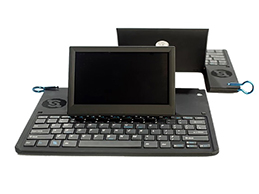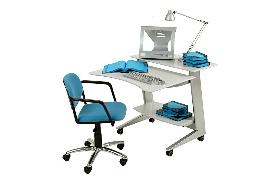On This Page
Introduction
Want to know more about the success of people with disabilities? JAN Success Stories are abundant. Dive in below for situations and solutions related to a variety of industries, jobs, impairments, and limitations. To learn more about JAN's case studies, go here. For additional success stories from JAN's funding agency and partners, see:
- Office of Disability Employment Policy: Read more Policies in Practice.
- What can You do? The Campaign for Disability Employment: Meet the "I Can" PSA Participants.
- Employer Assistance and Resource Network (EARN): EARN's Success Stories describe employers' successful practices for outreach, recruitment, hiring, and accommodating workers with disabilities.
Situations and Solutions:
The following situations and solutions are real-life examples of accommodations that were made by JAN customers. Because accommodations are made on a case-by-case basis, these examples may not be effective for every workplace but give you an idea about the types of accommodations that are possible.

An applicant for a restaurant server position disclosed that he has been diagnosed with Charcot-Marie-Tooth and needs to wear a specific type of shoe.
The employer allows the applicant to deviate from the dress code if he is selected for the position. He can wear shoes of the type needed so long as they follow similar color schemes as the normal dress code policy.

A phlebotomist who is deaf was provided a text to speech device to communicate with patients.
He was also given a vibrating pager with visual display so he could be contacted while in remote locations of the hospital.

A locomotive operator with myocardial infarction experienced reduction in stamina exacerbated by working midnight shifts.
The employer required that he work only day and afternoon shifts to accommodate his restrictions.

A food service worker disclosed Hepatitis C to her employer. The employer was concerned that the employee would risk transmission through the food supply.
The employee provided a note from her doctor, indicating that Hepatitis C was "NOT transmitted through the food supply," and that the individual was "safe to perform the essential job functions." Note: Hepatitis A is a food borne illness, but Hepatitis C is not.

An administrator with epilepsy needed an emergency communication system to inform someone that she had a seizure.
JAN suggested using a two way radio.

A physician with muscular dystrophy was having problems getting up from a seated position after consulting with patients.
The individual was accommodated with a lift cushion for his chair.

An engineer with Parkinson’s disease was having difficulty concentrating and communicating.
The individual was accommodated with a quiet office free from distractions. In addition, her supervisor implemented a policy of scheduled interruptions with written reminders and assignments. The individual was also provided with a communication device.

A customer service agent for an insurance company was pregnant and experiencing significant leg and back pain when sitting for long periods of time.
She also needed to use the restroom frequently. The employer provided an adjustable workstation to enable the employee to alternate between sitting and standing positions. The employer also allowed her to take more frequent rest breaks by dividing her existing thirty-minutes of break time into several smaller increments of time so she could use the restroom as-needed.

A veteran who is now an office employee has PTSD and anxiety.
He is easily frightened when being approached unsuspectingly. This employee works in a structured cubicle environment facing his computer and cubicle walls, with his back to the cubicle entrance. He wants to be alerted when a coworker or supervisor walks into the cubicle behind him. JAN suggested using a monitor-mounted mirror, so he could see the entrance behind him. JAN also suggested placing a sensor mat at the entrance of the cubicle, which will make an audible alert when someone steps on it.

An employee with borderline personality disorder works as a hairstylist in a beauty salon.
At times, she becomes very upset and leaves work abruptly. The supervisor meets with her regarding these occurrences and the employee discloses her disability and explains that because of her work schedule, she has been unable to attend therapy and psychiatrist appointments, which has resulted in an exacerbation of her symptoms. The employer suggests providing her a consistent schedule, allowing her to keep the early part of the day open for her therapist and doctor appointments. The employer also agrees to allow the employee to take two additional unpaid breaks per shift. The accommodations result in the employee getting the treatment she needs, allowing her to continue working successfully in her position.
A help desk employee’s main job functions included troubleshooting the tech problems other staff members were experiencing.
He was highly competent in solving problems, but became impatient, rude, and disrespectful to his coworkers who contacted him for assistance. A new policy was instituted as an accommodation that allowed the employee to take requests for help by e-mail instead of in person or by phone. This accommodation greatly reduced the employee’s stress previously caused by the more personal face-to-face and telephone interactions with coworkers. The help-desk employee was now better able to keep his emotions and behavior in check.

An assembly line worker with bursitis in his knee was limited in his ability to stand.
His employer gave him a stand/lean stool, provided him with anti-fatigue matting, and purchased vibration dampening shoe inserts.

A truck driver with thoracic outlet syndrome was having difficulty driving for long periods of time and unloading bags at his delivery destination.
The employer installed a small crane in the back of the trailer and provided him with a lightweight aluminum hand truck to help him unload materials. The employer also provided the employee a steering wheel spinner knob to eliminate prolonged grasping of the steering wheel and an anti-vibration seat to cut down on fatigue.

A maintenance worker with rotator cuff syndrome was having difficulty reaching cleaning areas and moving cleaning supplies.
The employer replaced his tools with long-handled, pneumatic, and lightweight tools. The employer also provided him an electric cart.

An investigator was having problems balancing between reading text and his computer screen due to diabetic retinopathy.
Accommodations were made so he could use task lighting, a glare filter for computer monitor, and closed circuit television with a split screen to view text and the computer monitor at same time.

A customer service representative for a physician's office is currently undergoing treatment for an eating disorder.
One of his therapeutic tasks is to integrate many small meals into his daily routine. His office has a strictly-enforced policy that employees can only eat in the break room, out of sight from the patients. In order to keep from disrupting his production level and to aid in his recovery, his supervisor modified the workplace policy and allowed the employee to eat snacks at his desk.

A preschool teacher needed to read books aloud to students during circle time.
She had difficulty describing and talking about the pictures in the books because of her color vision deficiency. She wanted to be able to describe the pictures accurately in order to help the children learn their colors. She was sometimes able to get help from a teaching assistant, but wanted a more independent solution. A JAN consultant discussed free and low-cost apps for identifying colors and suggested that she use an app to familiarize herself with the colors used on various pages in advance. The teacher also made index cards with notes about the pictures that she wanted to describe and taped them to the back cover of each book while reading.

A receptionist requested to wear a mask due to fragrance sensitivity.
The employer initially agreed to this but the surgical mask scared some of the clients and was impacting their ability to work. A decorative mask cover was located that made the surgical mask look less intimidating.

A delivery person with AD/HD had difficulty with time management.
She spent excessive time making deliveries and would forget to return to the warehouse between daily runs. The employer provided a personal organizer watch that could be programmed to beep and display a written message many times throughout the day. This auditory and written prompt helped the employee move quicker from task to task, and helped remind her to return to the warehouse to gather her next load.

An administrative assistant in a large, busy, public office requested a more private workspace to help her handle stress and emotions brought on by the conversations she would overhear while customers were chatting.
Although she didn’t have in-person customer contact, she did answer phones while other employees were on their breaks. The employer agreed to move the employee to a small space in the back of the office that had previously been used as a catch-all area, requiring her to keep a watch on the phones when her co-workers were on break, but that could easily be done from a distance. She was able to better concentrate on her work and be much more productive in her new environment free of conversations.

An employee with interstitial cystitis needed to use the restroom once every hour.
The employer modified the company break policy, just for the employee, so that frequent restroom breaks could be taken.

An employee working as a law office clerk was having trouble reading the text on the memos she has being given by the lawyers in her office.
She disclosed that she had low vision due to albinism and requested that the memos be provided in large print. The employer made a policy that memos must be written in a minimum of 18 point font and also provided a stand up magnifier to assist in reading hand-written items.

An executive for a large corporation developed Guillain-Barré Syndrome and was not able to commute to work.
The employee was accommodated with a work-from-home arrangement and alternative input software to access a computer.

An employee who experienced gastroesophageal reflux disease (GERD) requested accommodations due to an exacerbation of symptoms when experiencing stress.
The employer worked with the employee to identify tasks that contributed to the employee feeling overly stressed during the workday. Although the employer did not have to eliminate essential functions of the job, they agreed to modify the employee’s break schedule so they could step away from their work periodically, supervisory methods were adjusted, and higher cubicle walls were provided so that the employee was less distracted by others.

An applicant for a truck driver position only has the use of one hand.
The employer agrees to allow the applicant to drive an automatic transmission truck and also outfit that truck with steering grips as an accommodation.

An applicant disclosed that she has Graves’ disease and mentioned trouble with writing due to persistent hand shaking.
The employer agreed to provide weighted pens to limit the effects of the hand shaking if the applicant is selected for the position.

A store clerk with an intellectual impairment had limited reading skills, making it difficult to return items to the shelf.
JAN suggested making picture labels for cases that matched shelf display boxes. This allowed the employee to match pictures, not words, when returning items to the shelf.

A product technician with chemical sensitivity was having respiratory distress due to some of the chemicals used in the production process.
As a reasonable accommodation, the employer provided a face mask, ear plugs, lab coat, and gloves. These were already being used by another department. The employer reported that the employee can now deal with his medical condition while he’s on the job. The change has also saved workers’ compensation costs and improved workplace safety.

A newly hired teacher with a seizure disorder used a service animal to alert her that a seizure was coming on. The school had a no-animal policy.
The school allowed the teacher to bring her service animal to work and to keep it with her in her classroom. She was also provided breaks to take the service animal outside and given the opportunity to educate coworkers about the use of service animals. The employer reported that the accommodation cost nothing and it was good for the students to see a service animal at work.

A medical technician who was deaf could not hear the buzz of a timer, which was necessary for specific laboratory tests.
An indicator light was attached to the equipment.

A newspaper reporter with ataxia had difficulty taking notes and processing auditory input during interviews.
The employee had been using recording devices, but called JAN looking for more ideas. The JAN consultant explained the use of the Smart Pen, which was eventually provided as a workplace accommodation.

A grounds keeping employee with hypothyroidism disclosed that he has trouble when needing to work outside during the winter due to the cold.
The employer provided the individual with heated clothing to wear while outside as well as periodic rest breaks to allow the individual to come back into the building more often to reduce exposure to the cold.

A bakery employee with ataxia was stumbling during her shift.
She was self-accommodating with a store shopping cart, but space was limited. The employer purchased a small rollator to help the employee maintain balance while working.

A financial analyst with sleep apnea often fell asleep while working at her computer.
The employer provided her with a small device called a Doze Alert that fits in her ear and sounds whenever her head starts to drop forward as she falls asleep.

Isaiah is a janitorial employee with fetal alcohol syndrome who had difficulty organizing his supplies and knowing what to do differently in various areas.
To accommodate him, the employer color-coded the rooms and the lists of needed supplies for each of the different areas. Isaiah was also provided with a color-coded flip chart for the varied tasks.

A building contractor with dyscalculia was inefficient when creating job quotes.
To ensure the mathematical calculations were accurate, the employee spent extra time “figuring” and “double-checking” the numbers. The site supervisor purchased a contractor’s calculator to help the employee “figure” fractions, triangles, circles, area (and more) efficiently and accurately.

A salesman with obesity had to travel by airplane once a year to attend a conference, but could not fit in a single, economy class seat.
He asked his employer to upgrade him to first class, but the employer opted to purchase two economy class seats for him, which cost less than one first class ticket.

A dispatcher with shift work sleep disorder worked rotating shifts that caused his sleep disorder to be exacerbated.
The employer changed the rotating shift schedule for all employees to shifts that were assigned by seniority.

A scientist on the autism spectrum was able to speak at times but also experienced episodes when she found it difficult to speak and needed to use a speech device or speech generating app.
She was preparing to present her research at a conference. She pre-recorded audio to go with her slides and brought a tablet with a speech generating app with her in case she needed it during the question and answer portion of her presentation.

A teacher had been released to return to work following a stroke resulting in hemiparesis of her dominant left side.
The individual had undergone treatment and rehabilitation, but had trouble balancing, standing, walking, and grasping small items, such as a pen. Accommodations provided included a stand/lean stool, a height-adjustable laptop tray with a laptop connected to the classroom smart board, low-tech grip aids for writing, and grab bars placed along the walls of the class and in the hallways for assistance with balancing.

An employee discloses that because of his vertigo, it is difficult for him to make it to work on time in the morning, as the vertigo is more likely to flare up when he gets out of bed.
The employer allows the individual to have a flexible start time and make up the time at the end of the shift.

A user support specialist with stuttering used the TTY relay service as a backup means of communication at times when she found it difficult to speak on the telephone.
She became concerned about the confidentiality of this communication method and called JAN. A JAN consultant explained the FCC's confidentiality requirements for relay service providers, suggested that she contact the FCC directly for additional information, and discussed speech generating devices for use with the telephone as a potential alternative.

A custodian with low vision in a public school setting was having difficulty viewing the carpeted area he was vacuuming.
A lighting system was mounted on the custodian's industrial vacuum cleaner and the custodian was provided a headlamp.

An employee with spina bifida had difficulty accessing the employer's parking lot.
Because the employee's office was on the tenth floor, the employer agreed to provide a reserved parking space that was as close to the building as possible.

A switchboard operator with chronic pain and fibromyalgia was accommodated with flexible scheduling, rest breaks, and an adjustable workstation.
The adjustable workstation allowed her to alternate between a sitting and standing position.

A computer programmer with Hepatitis B was experiencing fatigue and nausea, which resulted in problems commuting.
The employer provided a modified schedule and gave the employee an option to work from home.
JAN Publications & Articles regarding Success Stories
Articles
Blog Posts
- Accommodating Cooks with Low Vision
- Accommodation Ideas for Individuals on Dialysis
- Assistance Dogs in the Workplace – Reflections on How to Make It Work – Part 1
- Assistance Dogs in the Workplace – Reflections on How to Make It Work – Part 2
- Healthcare Workers with Motor Impairments
- Healthcare Workers with Motor Impairments – Part 2
- Service Dogs as a Workplace Accommodation for Employees with Diabetes
- Work After Breast Cancer
Events Regarding Success Stories
- Upcoming Events
- Past Recorded Module
- Past In-person Training
- Past Exhibit Booths
- Past Webcast Series Training

